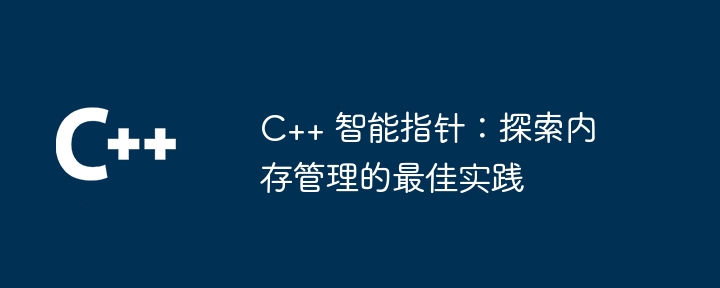C++ 智慧指標:探索記憶體管理的最佳實踐
C 智慧指標提供了對堆上分配物件的記憶體管理,包括獨佔所有權的 std::unique_ptr、共享所有權的 std::shared_ptr,以及用於追蹤物件存在的 std::weak_ptr。透過使用這些智慧指針,可以自動釋放記憶體並減少記憶體洩漏和懸空指針的風險,從而提高程式碼健壯性和效率。

C 智慧指標:探索記憶體管理的最佳實踐
##簡介#在C中有效管理記憶體對於編寫健全且高效的程式碼至關重要。智慧指標是一種現代 C 技術,它旨在簡化記憶體管理,避免常見的記憶體問題,例如記憶體洩漏和懸空指標。
智慧型指標類型C 中有幾種類型的智慧指針,每一種都有自己的用途:
- std ::unique_ptr:表示對堆上分配物件的獨佔所有權。當指標超出範圍或被銷毀時,它會自動刪除該物件。
- std::shared_ptr:表示對堆上分配物件的共用所有權。當最後一個指向該物件的共用指標超出範圍或被銷毀時,該物件將被刪除。
- std::weak_ptr:指向一個由其他智慧指標所持有的物件。它不能單獨管理物件的生命週期,但可以追蹤物件是否存在。
使用智慧指標使用智慧指標進行記憶體管理非常簡單:
// 使用 std::unique_ptr std::unique_ptr<int> pInt = std::make_unique<int>(10); // 分配并初始化堆上对象 // 使用 std::shared_ptr std::shared_ptr<std::vector<int>> pVector = std::make_shared<std::vector<int>>(); // 分配并初始化堆上对象 // 当 pInt 超出范围时,它会自动释放内存
實戰案例考慮一個模擬學生資料庫的簡單程式:
#include <iostream>
#include <vector>
#include <memory>
using namespace std;
class Student {
public:
Student(const string& name, int age)
: name(name), age(age) {}
const string& getName() const { return name; }
int getAge() const { return age; }
private:
string name;
int age;
};
int main() {
// 使用 std::vector<std::unique_ptr<Student>> 将所有学生存储在 std::vector 中
vector<unique_ptr<Student>> students;
// 创建并添加学生
students.push_back(make_unique<Student>("John", 22));
students.push_back(make_unique<Student>("Mary", 20));
// 遍历并打印学生信息
for (auto& student : students) {
cout << student->getName() << ", " << student->getAge() << endl;
}
return 0;
}std::unique_ptr 來管理每個學生的記憶體。當 student 指標超出範圍時,它會自動呼叫析構函數並釋放堆上分配的記憶體。
結論C 智慧指標是記憶體管理的強大工具,可以幫助開發人員編寫更健壯、更有效的程式碼。透過利用各種智慧指標類型,您可以減少記憶體洩漏和懸空指標的風險,從而大大提高應用程式的可靠性。
以上是C++ 智慧指標:探索記憶體管理的最佳實踐的詳細內容。更多資訊請關注PHP中文網其他相關文章!

熱AI工具

Undresser.AI Undress
人工智慧驅動的應用程序,用於創建逼真的裸體照片

AI Clothes Remover
用於從照片中去除衣服的線上人工智慧工具。

Undress AI Tool
免費脫衣圖片

Clothoff.io
AI脫衣器

AI Hentai Generator
免費產生 AI 無盡。

熱門文章

熱工具

記事本++7.3.1
好用且免費的程式碼編輯器

SublimeText3漢化版
中文版,非常好用

禪工作室 13.0.1
強大的PHP整合開發環境

Dreamweaver CS6
視覺化網頁開發工具

SublimeText3 Mac版
神級程式碼編輯軟體(SublimeText3)

熱門話題
 char在C語言字符串中的作用是什麼
Apr 03, 2025 pm 03:15 PM
char在C語言字符串中的作用是什麼
Apr 03, 2025 pm 03:15 PM
在 C 語言中,char 類型在字符串中用於:1. 存儲單個字符;2. 使用數組表示字符串並以 null 終止符結束;3. 通過字符串操作函數進行操作;4. 從鍵盤讀取或輸出字符串。
 在Docker環境中使用PECL安裝擴展時為什麼會報錯?如何解決?
Apr 01, 2025 pm 03:06 PM
在Docker環境中使用PECL安裝擴展時為什麼會報錯?如何解決?
Apr 01, 2025 pm 03:06 PM
在Docker環境中使用PECL安裝擴展時報錯的原因及解決方法在使用Docker環境時,我們常常會遇到一些令人頭疼的問�...
 c上標3下標5怎麼算 c上標3下標5算法教程
Apr 03, 2025 pm 10:33 PM
c上標3下標5怎麼算 c上標3下標5算法教程
Apr 03, 2025 pm 10:33 PM
C35 的計算本質上是組合數學,代表從 5 個元素中選擇 3 個的組合數,其計算公式為 C53 = 5! / (3! * 2!),可通過循環避免直接計算階乘以提高效率和避免溢出。另外,理解組合的本質和掌握高效的計算方法對於解決概率統計、密碼學、算法設計等領域的許多問題至關重要。
 c語言多線程的四種實現方式
Apr 03, 2025 pm 03:00 PM
c語言多線程的四種實現方式
Apr 03, 2025 pm 03:00 PM
語言多線程可以大大提升程序效率,C 語言中多線程的實現方式主要有四種:創建獨立進程:創建多個獨立運行的進程,每個進程擁有自己的內存空間。偽多線程:在一個進程中創建多個執行流,這些執行流共享同一內存空間,並交替執行。多線程庫:使用pthreads等多線程庫創建和管理線程,提供了豐富的線程操作函數。協程:一種輕量級的多線程實現,將任務劃分成小的子任務,輪流執行。
 distinct函數用法 distance函數c 用法教程
Apr 03, 2025 pm 10:27 PM
distinct函數用法 distance函數c 用法教程
Apr 03, 2025 pm 10:27 PM
std::unique 去除容器中的相鄰重複元素,並將它們移到末尾,返回指向第一個重複元素的迭代器。 std::distance 計算兩個迭代器之間的距離,即它們指向的元素個數。這兩個函數對於優化代碼和提升效率很有用,但也需要注意一些陷阱,例如:std::unique 只處理相鄰的重複元素。 std::distance 在處理非隨機訪問迭代器時效率較低。通過掌握這些特性和最佳實踐,你可以充分發揮這兩個函數的威力。
 蛇形命名法在C語言中如何應用?
Apr 03, 2025 pm 01:03 PM
蛇形命名法在C語言中如何應用?
Apr 03, 2025 pm 01:03 PM
C語言中蛇形命名法是一種編碼風格約定,使用下劃線連接多個單詞構成變量名或函數名,以增強可讀性。儘管它不會影響編譯和運行,但冗長的命名、IDE支持問題和歷史包袱需要考慮。
 C 中releasesemaphore的用法
Apr 04, 2025 am 07:54 AM
C 中releasesemaphore的用法
Apr 04, 2025 am 07:54 AM
C 中 release_semaphore 函數用於釋放已獲得的信號量,以便其他線程或進程訪問共享資源。它將信號量計數增加 1,允許阻塞的線程繼續執行。
 C 程序員&#s未定義行為指南
Apr 03, 2025 pm 07:57 PM
C 程序員&#s未定義行為指南
Apr 03, 2025 pm 07:57 PM
探索C語言編程的未定義行為:一本詳盡指南本文介紹一本關於C語言編程中未定義行為的電子書,共12章,涵蓋了C語言編程中一些最棘手和鮮為人知的方面。本書並非C語言入門教材,而是面向熟悉C語言編程的讀者,深入探討未定義行為的各種情況及其潛在後果。作者DmitrySviridkin,編輯AndreyKarpov。歷經六個月的精心準備,這本電子書終於與讀者見面。未來還將推出印刷版。本書最初計劃包含11章,但在創作過程中,內容不斷豐富,最終擴展到12章——這本身就是一個經典的數組越界案例,可謂是每個C程序員






